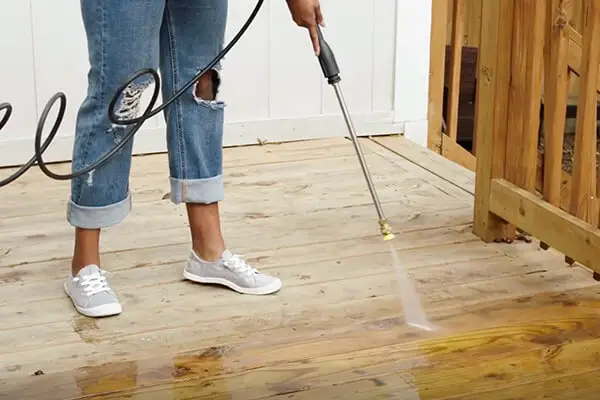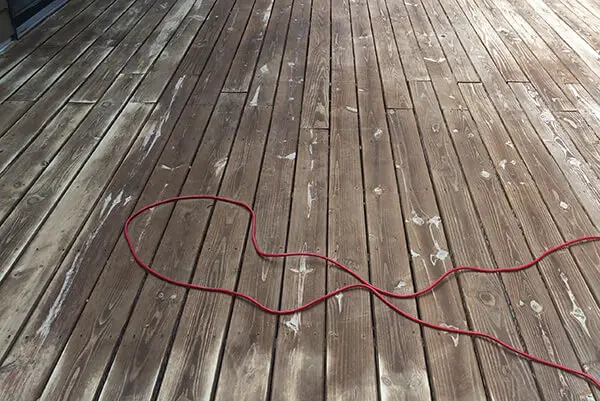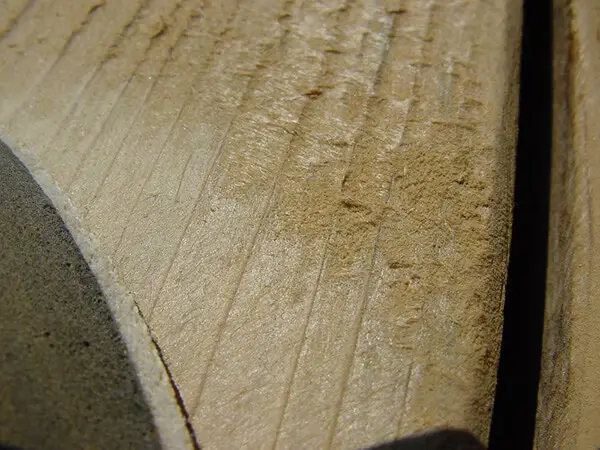When your deck is cleaned or stripped, you’ll likely end up with the deck fuzzy after power washing. On the decking boards, this seems to be highly tiny elevated wood grain threads or fibers.
Prepping a deck generally involves removing a layer of oxidized or damaged wood cells. The more you need to remove, the more likely the wood will appear “fuzzy” or “soft.” This look is entirely typical; it has no bearing on the longevity of a stain or sealer, and it does no damage to the wood.

However, it may look ugly and affect your garden appearance. So let’s find out what causes fuzzy wood and how to fix it!
Why Has The Deck Turned White After Cleaning?

Don’t panic if you’ve just spent a few hours recoating your deck only to discover white patches appear. The good news is that it is typical for a deck to be partially cured before it is entirely cured. So without lifting a finger, you may sit back and let the sun take care of things.
When water-based coatings come into contact with moisture before they are fully cured, white patches might form. However, the spots should dry out and disappear after a few days in the sun, leaving no evidence of anything but your handy work.
If the stains haven’t gone after a few weeks and you want your deck to look its best, just clean them with Cabot’s Deck Clean to remove any rain or other water residue. The stains will go away after the deck has been fully cured. It’s far too simple.
What Are Reasons For Deck Fuzzy After Power Washing?

Cedar boards, unlike other forms of natural wood decks, should be cleaned as soon as possible following installation. Cedar is a popular option for decks because it is naturally resistant to rot, rotting, and insects.
When washing a cedar deck with just about any type of cleaner, a white film known as “wood fuzzies” or “furring” might appear. Furring may happen when cedar is cleaned at any time, but it’s most common in two situations: fresh cedar and severely oxidized wood.
Heavily Oxidized Wood
The look of heavily oxidized cedar is drab and gray. In any case, it’s the damaged cells that are causing the boards to rise.
You’ll need to remove all damaged wood cells once the wood has turned gray (oxidized) from the UV. The more you remove off the surface of gray wood, the more you’ll need to remove from the surface, and the more likely you’ll acquire the “fuzzies.”
Deck Stain Stripped Away
The deck stain remover is a mild acidic that can give the wood grain a hairy appearance. The higher the dosage of the deck remover, the more likely the wood fuzzies would show up.
Dead Wood Removed
Pressure washing removes the dead wood’s surface covering, giving it the appearance of tiny fuzzy hairs. The breaking of the wood fibers causes this. This is typical and does not mean anything is wrong. In most cases, the fuzzies will go away in 2 to 3 weeks. After that, it’s OK to use a sealer on fuzzies.
How To Fix Fuzzy Wood After Pressure Wash
A light sanding can also be used to get rid of fuzzies. Depending on the amount of damage, a kitchen scrubber or a pool brush may be all you need to blend it in.
If the fuzzies are profound and widespread, sandpaper or bronze wool may be used. Bronze wool, rather than steel wool, is recommended since it does not leave a rust mark.
Steel wool can leave small steel particles on your wood deck if you clean it with it. They may not even be visible. But, on the other hand, the tiny particles will remain in the wood and will begin to oxidize with rain, resulting in rust marks.
- Step 1: Sand the deck after it has been washed for three days. To guarantee that all the fuzzy wood fibers are standing free from the deck’s surface and ready to be removed, the deck must be dry.
- Step 2: Sand an orbital sander with 80-grit sandpaper.
- Step 3: To protect yourself from splinters and dust particles, wear work gloves, safety goggles, and a face mask before you start sanding.
- Step 4: Begin in the farthest corner from the deck’s steps or entrance. Start by turning on the sander and moving it in tiny circles down each deck plank. Move at a moderate speed, eliminating the standing fibers but not for long enough to remove the plank’s top layer of wood.
- Step 5: Go to the next plank and repeat the process, continuing from plank to plank until there is no more fuzziness.
- Step 6: Use 80-grit sandpaper and a sanding block to sand away any fuzziness in hard-to-reach locations, such as around railing posts.
- Step 7: Using a stiff-bristled brush, sweep away the sawdust left behind after the sanding operation.
Check out this video to watch the deck’s sanding process:
How To Prevent Deck Fuzzy After Power Washing

Of course, this doesn’t always happen, and there are ways to prevent and fix it if the “Fuzzies” look bothers you. For example, to restore the color of an untreated deck exposed to the weather and turn gray (oxidized) due to UV exposure, you must remove all damaged wood cells.
The more grey and green on the wood, the more you’ll have to scrape off, and the more likely you’ll get the “fuzzies.”
You can see how vital it is to maintain your vehicle correctly and regularly. After a deck is created, it will take some time to weather and dry out due to the mill’s pressure treatment procedure.
Following the brief “drying” period, the deck must be stained within the first year of its existence and then maintained every two to three years after that. This will remove the possibility of “furring” in the first place.
Conclusion
Now you know how to remove the deck fuzzy after power washing: Give the deck a quick sanding. That’s it. All those fuzzy fibers will simply pop off easily after one quick pass of the sander. Pressure washing then sanding is my favorite way of preparing a deck for finishing or refinishing. So be careful and enjoy your beautiful deck!
Related Post


